Speed limits
| METRICATION: 10% complete | |||
 |
|||
| Metric | Non-metric | ||
| Speedometers required to show km/h. | Speedometers required to show mph. | ||
| Road sign specifications in millimetres. | All speed limit signs in mph. | ||
| HGV and PCV speed limiter regulations in km/h. | Road speed limit regulations in mph. | ||
| Digital tachographs record speeds in km/h, and distances in kilometres. |
Odometers use decimal miles. | ||
| Vehicle classification maximum design speeds in km/h. | |||
Following the conversion of Ireland’s speed limits to km/h in 2005, the UK remains the only major country in the world using miles per hour on red roundel restriction signs.
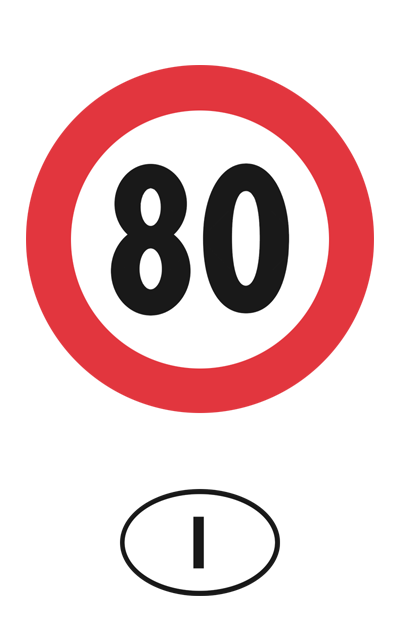 |
 |
 |
 |
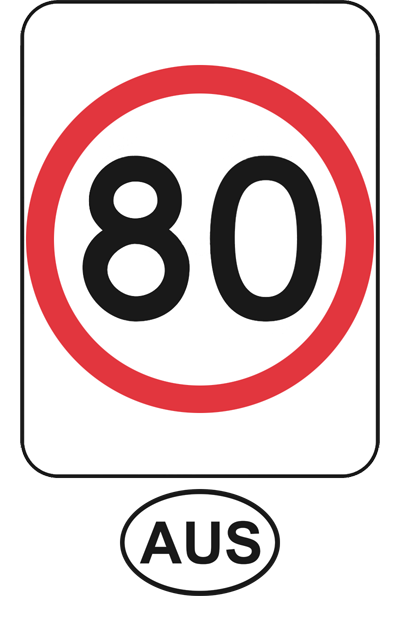 |
 |
 |
 |
The road signs above show how easily speed limit signs can be understood when travelling from one country to another, with the exception of the UK, which uses different numerical values for equivalent speeds, e.g. 50 mph ≈ 80 km/h.
The original plan
On 5 March 1969, as part of a wider national programme of metrication begun in 1965, the Government announced that speed limits would go metric in 1973. Speed limits on road signs would switch from miles per hour (mph) to kilometres per hour (km/h).
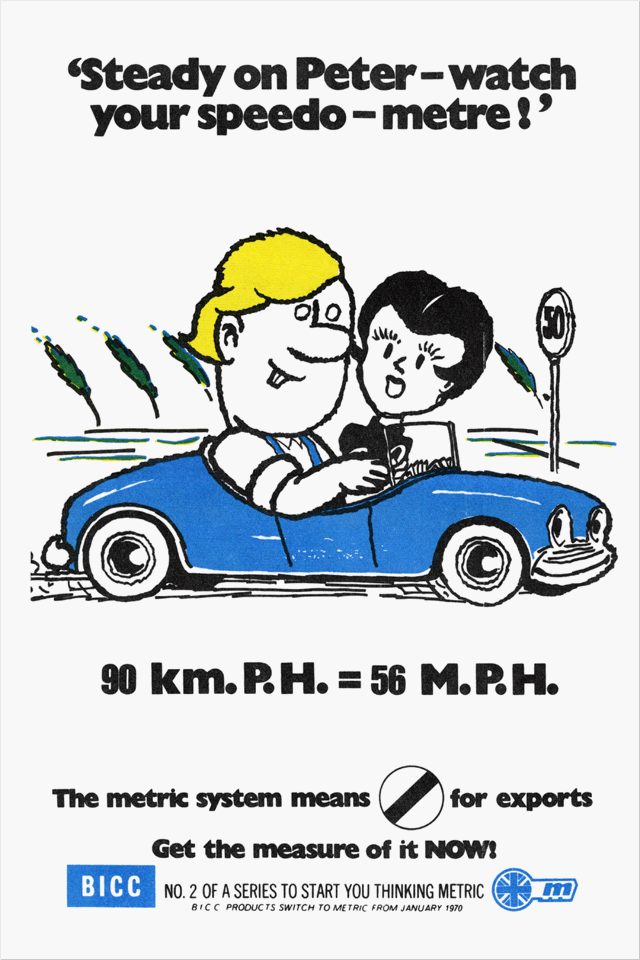
A metric information leaflet showing the forthcoming change to speed limits – 1969
Similar plans were announced throughout the Commonwealth in the 1970s. Australia switched on 1 July 1974, and New Zealand completed the change in 1975.
In the late 1960s, motor manufacturers were already fitting dual unit speedometers, capable of showing speeds in both mph and km/h, to a range of upmarket vehicles for sale in the UK.
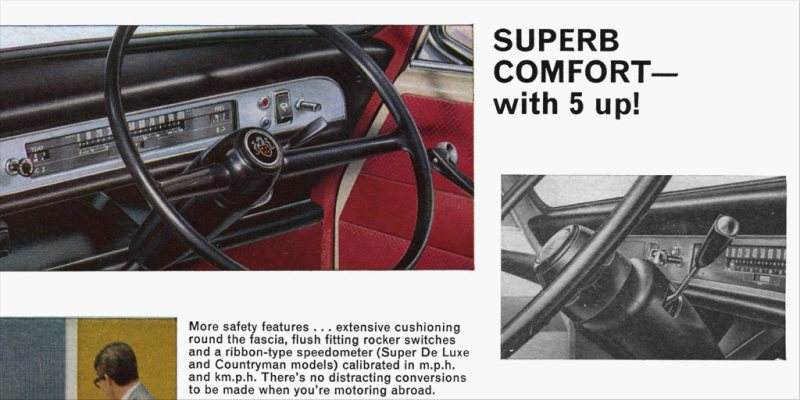
A dual unit speedometer, with mph and km/h scales in an Austin 1300 sales brochure – 1968
In addition to the expectation within the motor manufacturing industry that speed limits would soon go metric, having a speedometer capable of showing speeds in kilometres per hour was seen as an attractive selling point for new cars at a time when driving abroad was becoming increasingly practical.
Following the Government announcement in 1969, the number of new vehicles fitted with dual unit speedometers increased, and by 1972, in readiness for the switch to metric speed limits, dual unit speedometers had become standard issue in most new cars in the UK.

A dual unit speedometer, with mph and km/h scales in a Wolseley Six – 1972
If speed limit signs had subsequently been upgraded to metric units, as originally scheduled, single unit speedometers would once again have become the standard for all new vehicles in 1973. Only this time they would have been in km/h, and not the old miles per hour. However, on 9 December 1970, the Government postponed the UK’s 1973 switchover date, and stated that it had “no alternative date in mind”.
Since then, for more than fifty years, successive governments have failed to set a new date for the change to metric speed limits.
Ramifications of delaying metrication
The decision, in 1970, to postpone the switch to metric speed limits, had many knock on effects, all of which greatly outweighed any short term savings made on new signage.
The most immediate effect was to cause a crisis of confidence in the whole national metrication programme. There were real fears that metrication might be put into reverse. The construction sector was nearing completion of its metrication programme. A halt to metrication in 1970 would have been the worst possible outcome. Government assurances that it would ‘not impede’ further metrication in the construction industry were not enough. Representatives from both construction and industry expressed concerns that metrication in their sectors could not easily be completed in isolation from the rest of society, and requested a renewal of government commitment. Setting a new date for switching speed limits to metric units would have been the single most affirmative action that the Government could have made, but at that time, there was no going back on the decision to delay indefinitely the switch to metric speed limits.
However, the Government was persuaded to draft a White Paper on Metrication, which was eventually published in 1972. This laid out the Government’s policy for metrication across wider society for the rest of the decade. The 1972 White Paper included plans for industry, defence, freight, retail, agriculture, and education. The need to metricate road signs was acknowledged, but no immediate plans were included.
| “… The change of speed and distance signs to metric units will need to be considered in detail, but not for some years.“ |
Government White Paper on Metrication – 1972
50 years on, it would seem that the time for the “change of speed and distance signs … to be considered in detail” is long overdue.
The increasing need for metrication
Since 1970, the case for metric road signs has continued to grow stronger, and the retention of miles per hour for speed limits has become ever less tenable. In recent years, some of the most persuasive reasons for the change have emerged, including a huge increase in international travel, the development of new exclusively-metric technologies, and the successful adoption of the metric system across wider society.
However the single most compelling reason for the change remains the same as it was back in 1970 – Education. Every child’s education suffers from not seeing the measurement units that they learn at school from being used in practice, in the most visible way possible, in the world outside school.
The case for metric speed limits
| Comprehension | Since 1970, the proportion of UK drivers that have been taught exclusively in metric has increased. Today, nearly all drivers of working age in the UK have not been taught imperial units at school, yet when reading road signs, drivers are expected to know whether 800 yards is more or less than half a mile. In contrast, it is common knowledge that 1000 m equals 1 km. |
| Global standard | Apart from the USA, the UK remains the only major country in the world not to have adopted km/h for speed limits. |
| International travel | Since 1970, international travel has increased greatly. Every year more than 3 million foreign registered vehicles enter the UK. Few of these vehicles have speedometers that show speeds in miles per hour. This has clear implications for road safety. |
| Land border | Since 20 January 2005, the UK has had a land border with a country with metric speed limits. |
| Digital tachographs | Standard digital tachographs, introduced in the 2000s, are exclusively metric. |
| Speed limiters | International speed limiter regulations, introduced in the 2000s, are exclusively metric. |
| Wider society | For all official purposes, wider society is now almost totally metric. Road signs that use imperial units have become a very visible anachronism. |
Global standard
Since 1970, the kilometre per hour, symbol km/h, has become the global standard unit for the measurement of road speeds and the setting of speed limits. The UK is now one of only two major countries holding out with speed limits in miles per hour.
Speed limits in km/h are the global standard

■ km/h ■ mph
Speedometers
Even though the introduction of metric speed limits was postponed in 1970, some preparations for the change continued.
From 1977, in accordance with agreed international vehicle standards, all new vehicles have been required to be fitted with speedometers capable of showing speeds in both km/h and mph. This means that when speed limits go metric, practically every vehicle on UK roads will be capable of displaying vehicle speed in km/h without any modifications needing to be made.
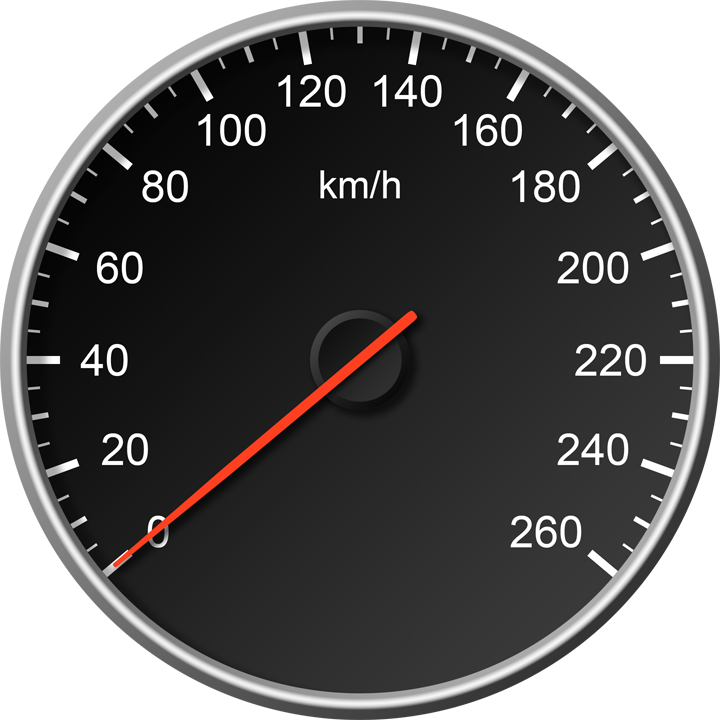 |
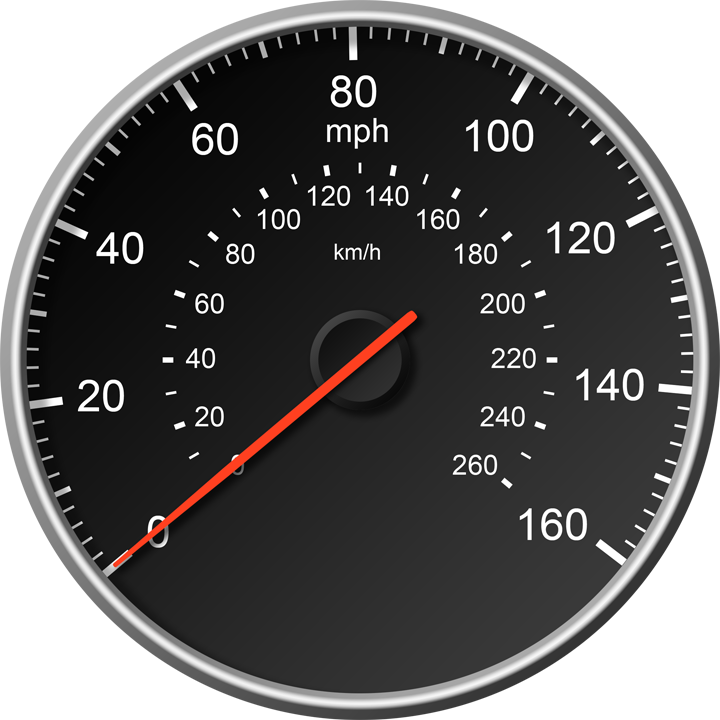 |
|
| GLOBAL | BRITAIN |
In countries with metric speed limits, vehicles use standard, easy-to-read, single unit speedometers. In readiness for metrication, and to facilitate travel outside the UK, vehicles manufactured for the UK market are required to be fitted with special dual unit speedometers.
Switching speed limits to kilometres per hour will enable owners of all subsequently registered vehicles to benefit from single-unit metric speedometers, with clutter-free displays. Speedometers with dual unit scales will no longer be required.
International travel and road safety
Since 1970, international travel has increased greatly. In 2007, a report commissioned by the SPARKS Programme estimated that over 3 million foreign registered vehicles were entering the UK each year.
In general, foreign registered vehicles are fitted with speedometers that are not capable of displaying speeds in miles per hour. For these drivers, the UK’s use of miles per hour for speed limits is a safety issue.
In contrast, all UK registered vehicle have speedometers that can display speeds in both km/h and mph.
Speed limits in mph are not compatible with every speedometer in the UK
| Speed limit signs | UK vehicles | Vehicles visiting UK | Compatible |
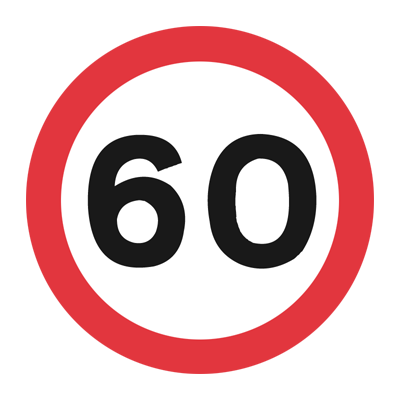 mph |
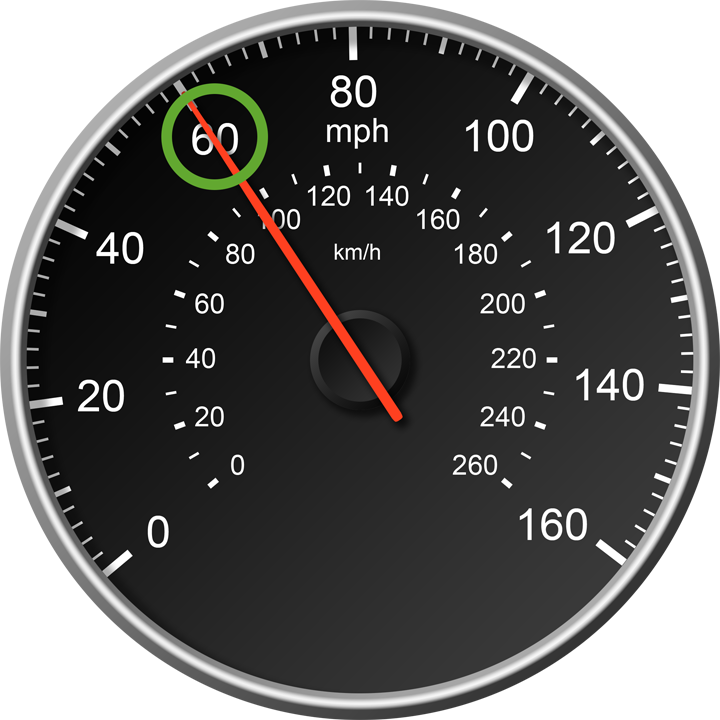 |
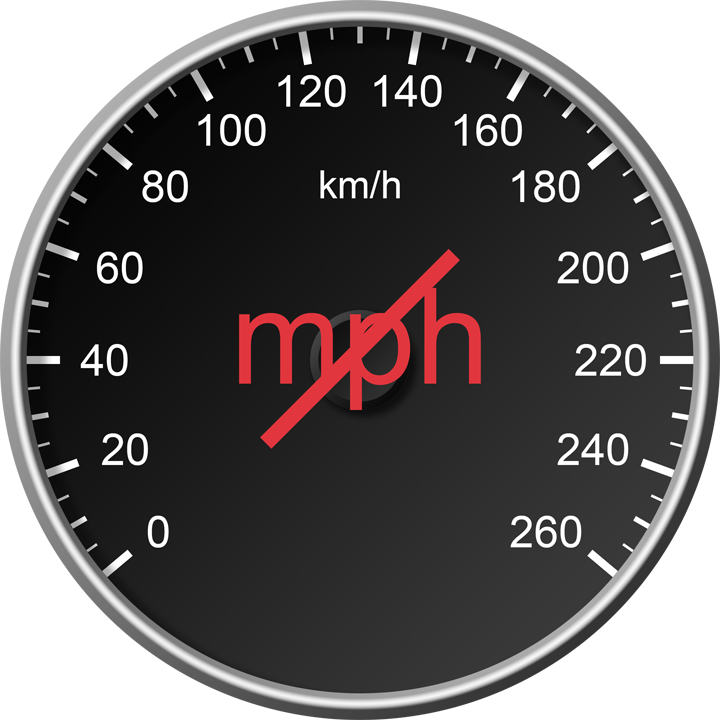 |
 |
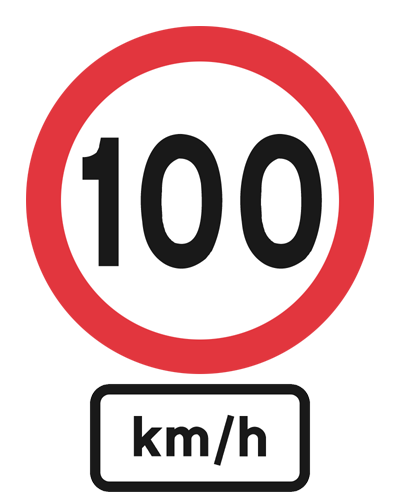 |
 |
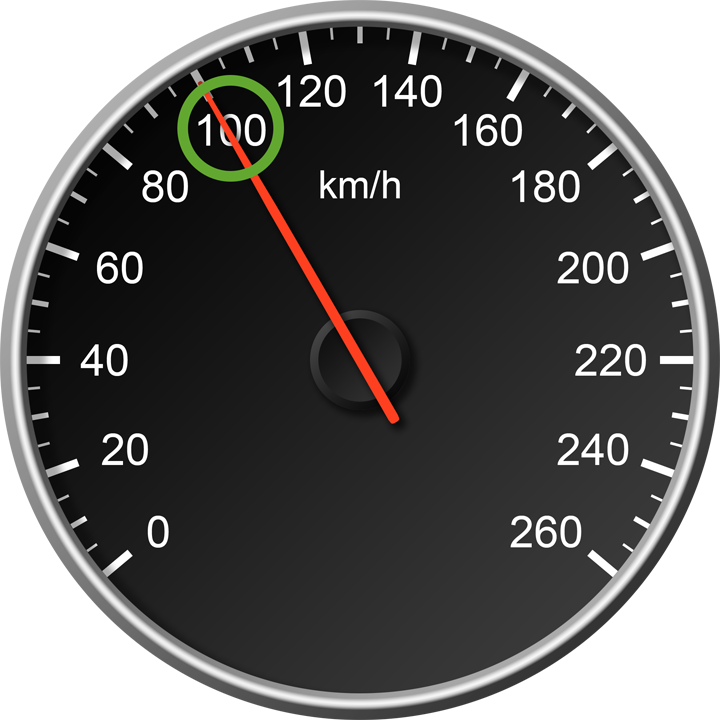 |
 |
Unlike current speed limits in miles per hour, speed limits in kilometres per hour will be compatible with the speedometers of all vehicles on UK roads.
It follows that switching speed limits to km/h would be a major improvement in road safety. The confusion caused by the use of two different units for speed would finally end.
The Highway Code
As a consequence of Ireland’s switch to kilometres per hour for all speed limits in 2005, practically every foreign-registered vehicle entering the UK now comes from a country whose drivers cannot be expected to be familiar with speed limits in miles per hour.
This, together with the fact that foreign registered vehicles are generally fitted with speedometers incapable of displaying speeds in miles per hour, means that the UK’s use of miles per hour for speed limits is a vital safety issue for drivers visiting the UK.
In 2007, the fifteenth edition of the official Highway Code went some way to addressing this issue. Metric equivalents of all references to speed were introduced. All speeds in miles per hour, or mph, were accompanied by a km/h equivalent in brackets.
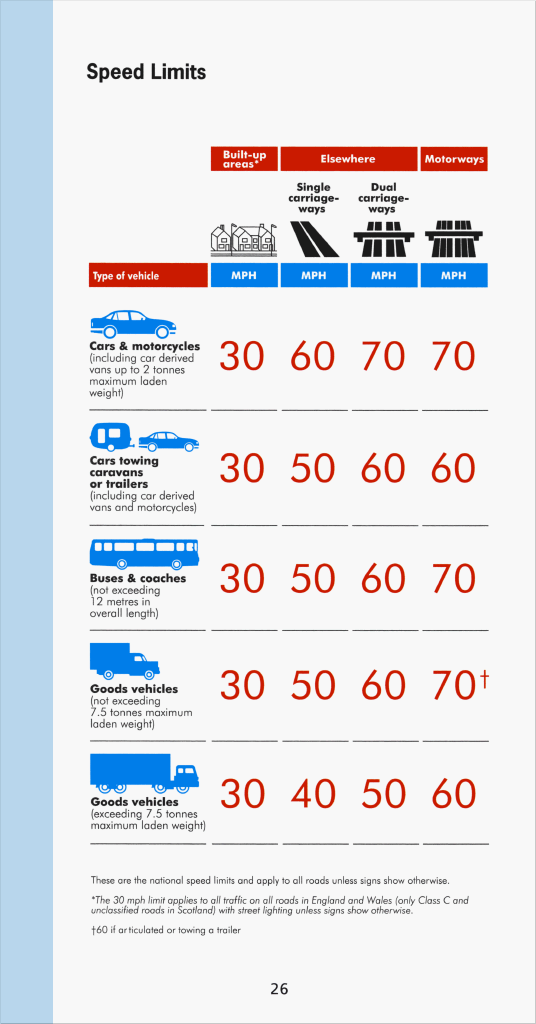 The Highway Code – 2004 |
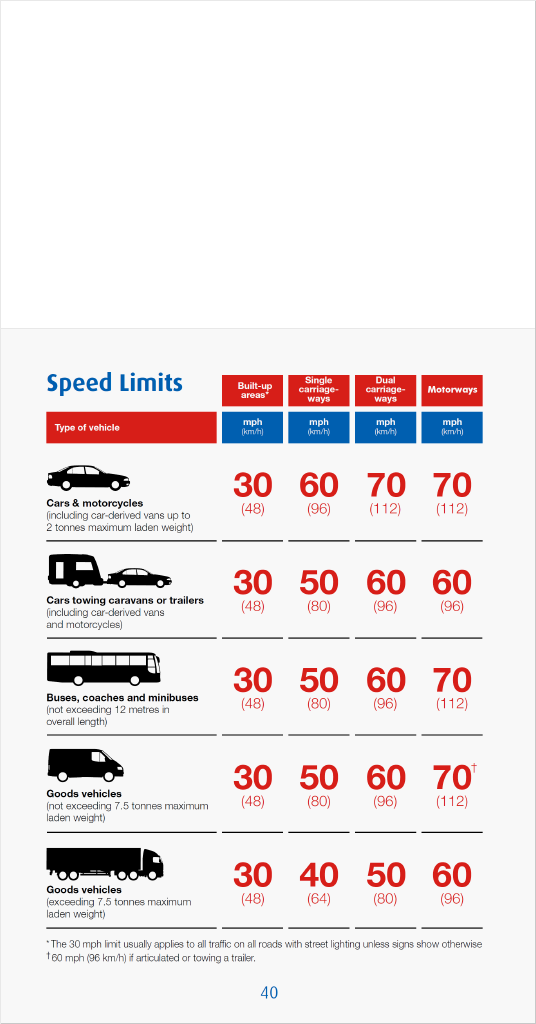 The Highway Code – 2007 |
In addition to providing vital information for foreign drivers visiting the UK, the Highway Code’s use of metric speed equivalents also helps UK drivers to become familiar with speeds in kilometres per hour – something that cannot be avoided when driving outside the UK. The information also helps all road users prepare for when the UK switches its own speed limits to kilometres per hour.
Digital tachographs
Since 1 May 2006, for safety purposes, all new HGVs have been required to be equipped with digital tachographs.
Digital tachographs record speeds, distances, driving periods and break durations. Distances travelled are recorded in kilometres, speeds are recorded in km/h.
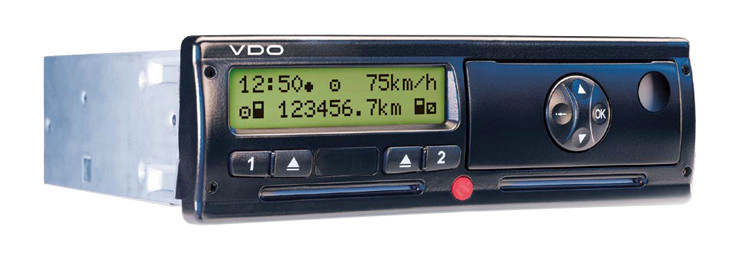
Digital tachographs allow compliance with legal requirements, concerning the driving and rest times of professional drivers, to be checked.
Switching speed limits to kilometres per hour, and odometers in new vehicles to metric units, will harmonise the use of digital tachographs with other vehicle applications.
Speed limiters
Since 1970, the most glaring issue that has arisen as a consequence of retaining miles per hour for speed limits, is the conflict that now exists between imperial road speed limits and twenty-first century metric speed limiters. An issue that would never have existed in the first place had the metrication of speed limits gone ahead as planned in 1973.
Speed limiters are safety devices which restrict the powered speed of a vehicle above a defined limit. In recent decades, the range of vehicles requiring speed limiters has widened.
Since 1 January 2005, if used outside the UK, all new goods vehicles with a design weight over 3.5 tonnes and all new passenger carrying vehicles, PCVs, with more than 8 passenger seats (regardless of weight) have been required to be fitted with a speed limiter. From 1 January 2008, this requirement extended to vehicles used solely in the UK. These speed limiter settings are defined in kilometres per hour.
For any given class of vehicle, the motorway speed limit is the maximum legal speed that a vehicle can travel at on public roads. Currently, all motorway speed limits are defined in miles per hour.
It makes no sense to have motorway speed limits that are in excess of speed limiter settings, but for some classes of commercial vehicle, that is exactly what we currently have in the UK.
Speed limits in mph are incompatible with speed limiters
| Vehicle class | Speed limiter setting | Motorway speed limit | Compatibility |
 Buses, coaches and minibuses (not exceeding 12 m overall length) |
 |
 112 km/h |
 Motorway speed limit exceeds speed limiter setting by 12 km/h |
 Buses, coaches and minibuses (exceeding 12 m overall length) |
 |
 96 km/h |
 Speed limiter setting exceeds motorway speed limit by 4 km/h |
 Goods vehicles (not exceeding 7.5 t maximum laden weight) |
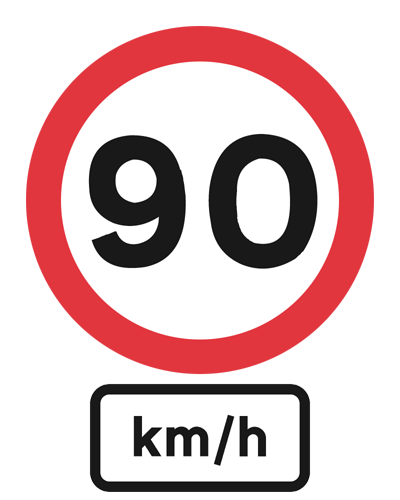 |
 112 km/h |
 Motorway speed limit exceeds speed limiter setting by 22 km/h |
 Goods vehicles (exceeding 7.5 t maximum laden weight) |
 |
 96 km/h |
 Motorway speed limit exceeds speed limiter setting by 6 km/h |
Of course, speed limits in mph for commercial vehicles could be set to more closely, but not precisely, match their speed limiter settings, such as 56 mph (90.1 km/h), and 62 mph (99.8 km/h).
However, without expanding the current schedule of speed limits to include values other than multiples of 10, this is not possible while holding on to the notion that all speed limits must be in miles per hour.
In practice, this legal conundrum has simply been ignored. Even as recently as 2015, the maximum speed limit for HGVs of over 7.5 t was increased to 60 mph (96 km/h) on dual carriageways in England and Wales. That’s 6 km/h higher than their speed limiters allow.
The simplest solution would be for dual carriageway and motorway speed limits to be set in km/h for all affected goods vehicles and passenger carrying vehicles.
Speed limits in km/h will be compatible with speed limiters
| Vehicle class | Speed limiter setting | Motorway speed limit | Compatibility |
 Buses, coaches and minibuses (not exceeding 12 m overall length) |
 |
 |
 Motorway speed limit matches speed limiter setting |
 Buses, coaches and minibuses (exceeding 12 m overall length) |
 |
 |
 Motorway speed limit matches speed limiter setting |
 Goods vehicles (not exceeding 7.5 t maximum laden weight) |
 |
 |
 Motorway speed limit matches speed limiter setting |
 Goods vehicles (exceeding 7.5 t maximum laden weight) |
 |
 |
 Motorway speed limit matches speed limiter setting |
There is no good reason why this solution should not be implemented without delay. It can be carried out at zero cost, and does not require any road signs to be changed. This is because the only speed limit regulations that are involved are those affecting certain classes of commercial vehicle, and these speed limits are not currently signed on UK roads.
Of course, the whole issue will disappear when all road speed limits switch to metric. Setting road speed limits in km/h will allow the harmonisation of speed limiter legislation with road speed limits, e.g. the dual carriageway speed limit for HGVs could be set at 90 km/h to match the 90 km/h speed limiters fitted to HGVs.
Classification of power-driven vehicles
For regulatory purposes, all motor-powered vehicles are classified according to vehicle construction type.
For type approval, vehicle category definitions in the UK follow the United Nations Regulations (formerly known as UNECE Regulations). All maximum design speed requirements are specified in km/h.
Examples of vehicle category definitions
| Vehicle | Category | Definition |
| Electric bicycle | L1 | A two-wheeled vehicle with an engine cylinder capacity in the case of a thermic engine not exceeding 50 cm3 and whatever the means of propulsion a maximum design speed not exceeding 50 km/h. |
| Motorcycle | L3 | A two-wheeled vehicle with an engine cylinder capacity in the case of a thermic engine exceeding 50 cm3 or whatever the means of propulsion a maximum design speed exceeding 50 km/h. |
| Mobility scooter | L6 | A vehicle with four wheels whose unladen mass is not more than 350 kg, not including the mass of the batteries in case of electric vehicles, whose maximum design speed is not more than 45 km/h, and whose engine cylinder capacity does not exceed 50 cm3 for spark (positive) ignition engines, or whose maximum net power output does not exceed 4 kW in the case of other internal combustion engines, or whose maximum continuous rated power does not exceed 4 kW in the case of electric engines. |
Switching speed limits to kilometres per hour will enable a single measurement system to be used for all aspects of road vehicles.
Sign specifications
In common with other road signs, the dimensions of speed limit signs are specified in millimetres.
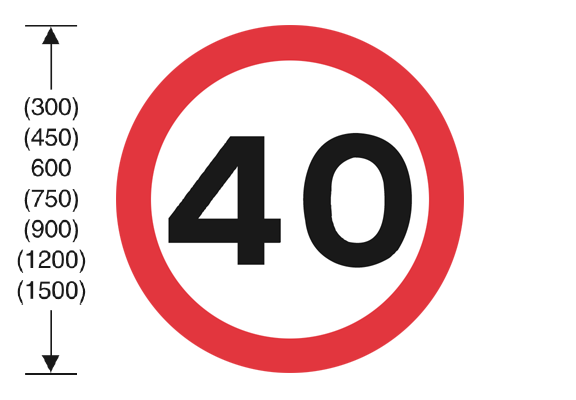
TSRGD – Diagram 670 – Maximum speed limit in miles per hour
The only imperial unit used on a UK road speed limit sign is the miles per hour value that it displays.
Metrication
When speed limits finally switch to kilometres per hour in the UK, it will be necessary to convert all speed limit signs from mph to km/h within a short time frame.
Experience in other countries shows that, with sufficient preparation, this is a straight forward process, and can be a carried out within one day. It is convenient to refer to this event as Metrication Day, or M-day.
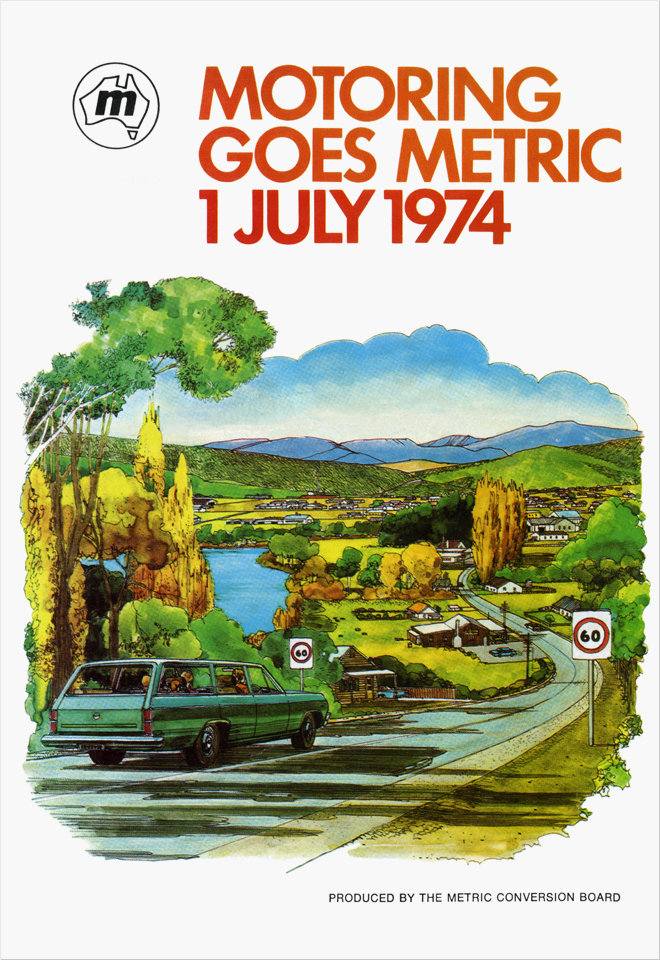 M-Day, Australia – 1974 |
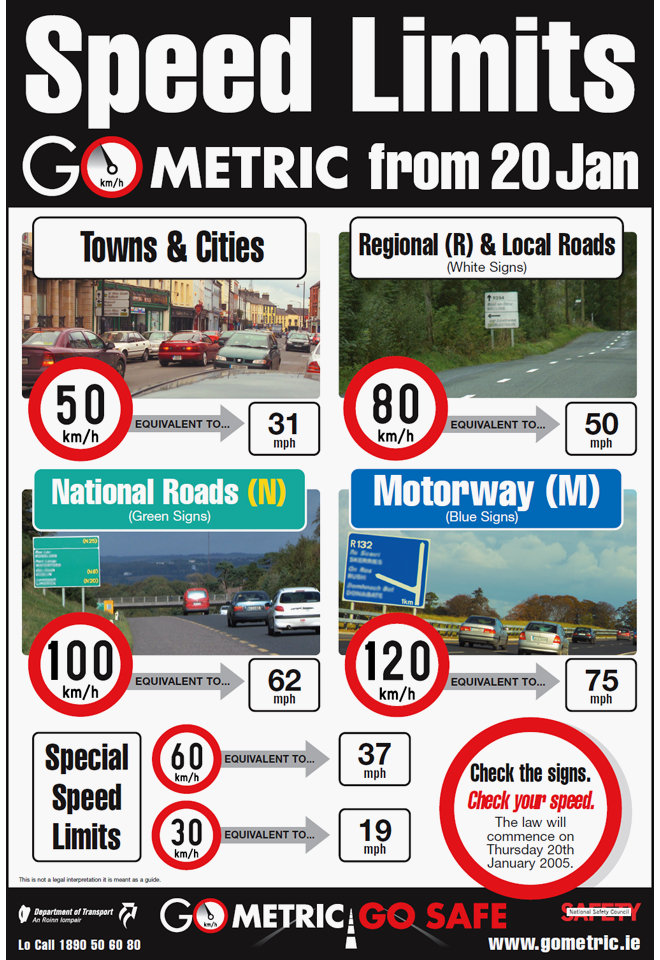 M-Day, Ireland – 2005 |
Metrication will also present a convenient opportunity to replace “national speed limit applies” signs with appropriate standard speed limit signs. Internationally, the black diagonal on white roundel signifies “end of restriction” and not “national speed limit applies”.
The following examples describe different methods that can be used to switch speed limit signs from mph to km/h.
Method 1
Method 1 is a one stage process, and is the method used in Ireland in 2005. Old roundels with numerals will be replaced with new roundels with numerals and a km/h symbol.
One disadvantage of this method is that any requirement to prevent the font size of the numerals on the new roundels from being smaller, will mean that the new roundels will have to be slightly larger. This will require extra work at the initial survey stage.
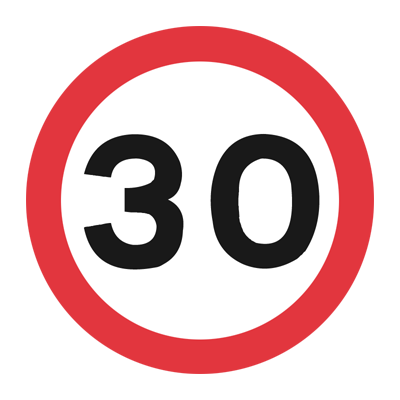 |
 |
 |
 |
| Current signs | |||
In the weeks prior to M-day, new signs are installed adjacent to existing signs. These signs remain hooded until M-day.
On M-day, the new signs are revealed and the old ones are obscured. The old posts are then removed over the following weeks.
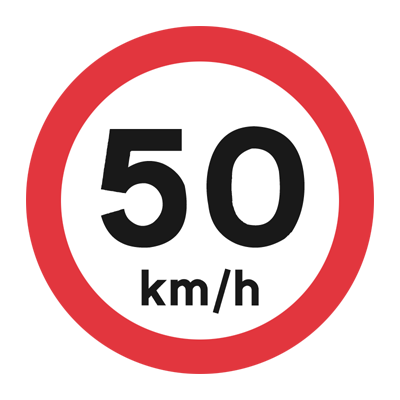 |
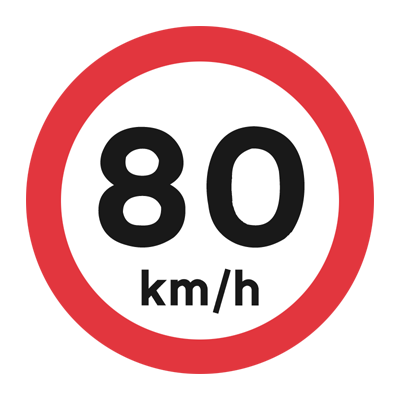 |
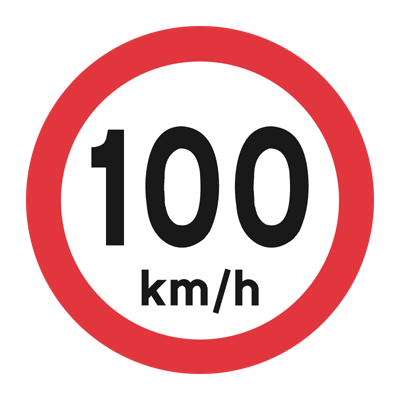 |
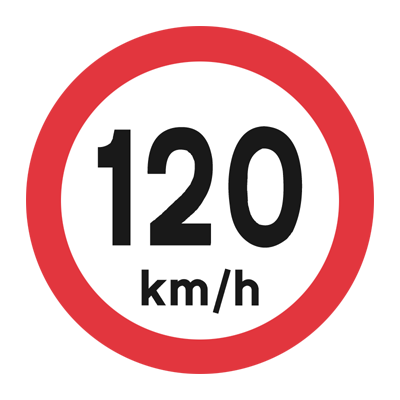 |
| M-Day | |||
The new signs include the “km/h” symbol to distinguish them from the old mph signs.
In Wales, when tens of thousands of 30 mph signs needed to be replaced with 20 mph signs to coincide with a nationwide change of the speed limit in built-up areas on 17 September 2023, the old 30 mph roundels were replaced with 20 mph roundels over a period of months. The new signs were installed with temporary overlay stickers showing the old 30 mph value. The stickers were designed to be removed quickly and easily, enabling the vast majority of signs to be changed overnight. A similar method could be used across the UK for a rapid switch of all speed limit signs to km/h values.
Method 2
Method 2 is a two stage process. The process is essentially the same as Method 1, except that a km/h symbol is not included on the new roundel. Instead, a temporary supplementary “km/h” plate is attached to the new sign post, immediately below the roundel.
One advantage of this method is that the font size of the numerals on the new roundels will be the same as on the old ones. This will make the initial survey stage more straight forward.
 |
 |
 |
 |
| Current signs | |||
Stage 1
Stage one occurs on M-day. The new signs are revealed and the old ones are obscured. The old posts are then removed over the following weeks.
The use of a supplementary “km/h” plate allows for a less cluttered roundel and, when complying with any font height requirements, it prevents the need for larger roundels to be used if the km/h symbol was to be included on the roundel itself.
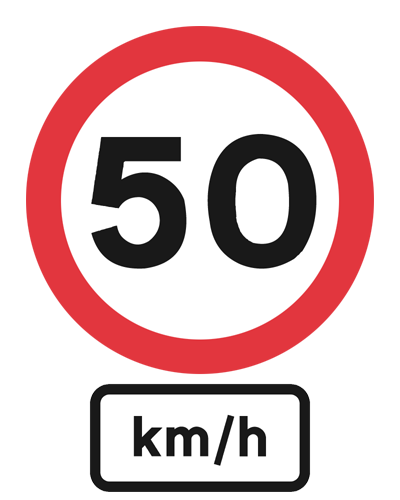 |
 |
 |
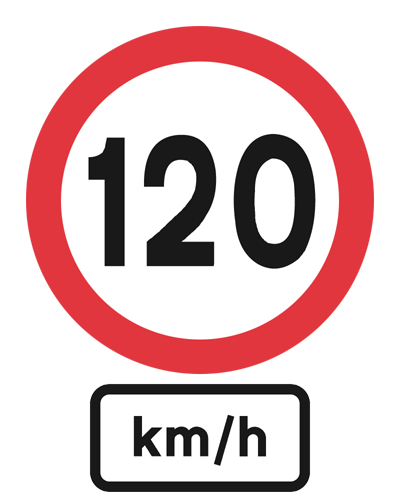 |
| M-Day | |||
From M-Day onwards, the numeric values on all speed limit signs will be legally interpreted to be in in km/h, regardless of whether they have a supplementary “km/h” plate. For example, if an old 30 mph sign managed to escape the conversion process, from M-Day onwards it would be legally interpreted as 30 km/h, and any new 50 km/h sign missing its supplemenatary plate would still be legally interpreted as 50 km/h.
Stage 2
Stage two of the process begins about 6 months after M-day. It involves the removal of the temporary “km/h” plates from the new signs.
 |
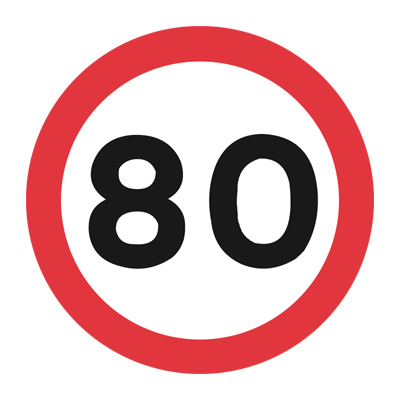 |
 |
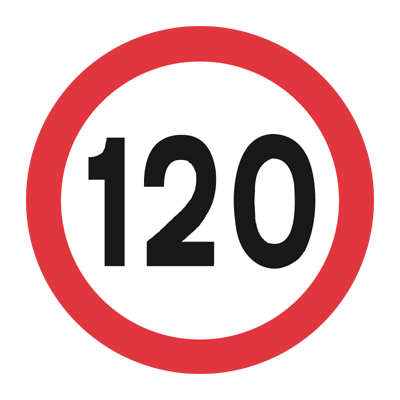 |
| M-Day + 1 year | |||
A few months after M-day, the “km/h” symbol will have become superfluous information, in much the same way as the word “NEW” became redundant on “10 NEW PENCE” coins shortly after the decimalisation of money.
Stage two can be carried out at low cost over a period of about 6 months, with the aim that it should be complete within 1 year after M-day.
Of the two methods, method 2 produces the more desirable end result and, despite the relatively small additional one-off cost of temporary “km/h” plates, method 2 might prove to be less expensive in the long term, owing to the ongoing costs of the slightly larger signs required for method 1.
As part of a general program to convert all road signs to metric units, speed limits should switch to kilometres per hour (km/h).
All new vehicles will be fitted with easy-to-read single unit km/h speedometers.
Benefits of metric speed limits
Just as the negative consequences of retaining imperial speed limits have increased since the 1970s, so too have the potential benefits of switching to metric speed limits at the earliest practical date. These are some of the benefits:
- Safety – More than 3 million foreign-registered vehicles enter the UK each year. Most of these vehicles’ speedometers show speeds in km/h only, and are incapable of displaying speeds in mph. In contrast, the speedometers fitted in UK-registered vehicles are required to display speeds in both km/h and mph. Switching speed limits to km/h will mean, at a stroke, that all vehicles driving on UK roads will have speedometers that display speeds in the same units as those used on road signs. This would be an undeniable improvement in road safety.
- Clarity – The need for dual unit speedometers, with their cluttered displays, will end. All new vehicles will be fitted with easy-to-read single unit speedometers. Metric speedometers are standard components, and so should be less expensive than bespoke dual-unit devices.
- Digital tachographs – Metric speedometers will use the same units as used in standard digital tachographs.
- Speed limiters – Setting road speed limits in km/h will allow the harmonisation of speed limiter legislation with road speed limits, e.g. the dual carriageway speed limit for HGVs could be set at 90 km/h to match the 90 km/h speed limiters fitted to HGVs.
- International vehicle specifications – Metric speedometers will use the same units as maximum design speeds in vehicle category definitions.
- Versatility – Metric speed limits will provide highway authorities with a wider range of speed restrictions, enabling speed limits to be more finely tuned to the circumstances of individual roads.
Fine tuning of speed limits in built-up areas
In 1990, the Department of Transport set out guidelines for the introduction of 20 mph (32 km/h) speed limit zones. This initiative was based on international experience, which had shown that lower speed limits could have safety benefits when combined with traffic calming measures to ensure that vehicles maintained low speeds through the zone. Initially local authorities had to apply for consent from the Secretary of State to introduce a 20 mph zone, but in 1999, legislation was introduced giving Highways Authorities the ability to introduce 20 mph speed limits without needing to apply for permission.
In Wales, the safety benefits that followed the introduction of 20 mph speed limits were significant enough to persuade the Welsh Government that a reduction of the default speed limit on roads in built-up areas was justified.
In 2022, the Welsh Senedd voted to change the default speed limit in built-up areas in Wales from 30 mph to 20 mph. The change came into effect on 17 September 2023.
This major departure from speed limits across the border in England, together with Scotland’s divergence of HGV speed limits in 2016, means that all three nations on the island of Britain now have their own road speed limits schedule. This can only increase the likelihood of one or more of the nations of the UK switching to metric speed limits independently of the rest of the UK.
In 2005, when Ireland switched to metric speed limits, the authorities took advantage of the opportunity that it presented to review all road speed limits. Similarly, in Wales in 2022, the review of the default speed limit in built up areas would have been a good time to switch to metric speed limits – It makes little sense to invest in a lot of new road signs, only to have to replace them again when road signs go metric.
Speed limits in km/h have a more versatile range of values

When fine tuning lower speed limits, metric speed limits are significantly more versatile than imperial. For speed limits under 30 mph (48 km/h), the only practical imperial option is 20 mph (32 km/h). Whereas, using metric, there are three possible choices: 20 km/h, 30 km/h or 40 km/h.
When reviewing the default speed restriction in built up areas in Wales, switching all speed limits to metric at the same time would have enabled the following benefits:
- A less drastic reduction, to 40 km/h, would have been possible, making the change less controversial.
- Speed limits can be more finely tuned to the circumstances of individual roads using either 20 km/h, 30 km/h or 40 km/h.
- Cost savings would have been possible. All existing 30 mph signs, destined to be replaced with 30 km/h signs, could have been converted simply by adding a supplementary plate of “km/h” plate.
While the Government continues to postpone the metric changeover for UK road signs as a whole, the increased versatility offered by metric speed limits, especially for the fine tuning of lower speed restrictions, may yet prove to be the deciding factor for Wales and Scotland to independently switch to metric speed limits.
Benefits of metric road signs
More generally, the benefits of using metric units for all road signs extend further:
- Education – Metric road signs will be a very visible use of the measurement units that children learn in school being used in the wider world. This reason alone should be sufficient to carry out the change.
- Comprehension – The vast majority of drivers on UK roads were not taught imperial units at school, yet when reading road signs, all UK drivers are expected to know whether 800 yards is more than half a mile, or less. In contrast, it is common knowledge that 1000 m equals 1 km.
- Odometers – Imperial odometers are of little practical use for measuring short distances. Metric odometers are far more useful. For example counting the distance in units of 100 m to a hazard 800 m away is straight forward with a metric odometer, but counting the distance in units of 176 yards to a hazard 800 yards away is not worth the mental effort involved using an imperial odometer.
- Fuel consumption – The UK is probably unique in the world in using litres for fuel sales, and miles for road distances. This means that both the old miles per gallon unit of fuel consumption, and the modern metric unit of L/100 km have little meaning to UK drivers. Fuel consumption figures serve only as comparisons between different models when purchasing a new vehicle.
- International standards – The UK uses international standard symbols on road signs, as laid out in the 1968 Vienna Convention. Adopting international standard measurement units will complete the process.
- Borders – Crossing UK borders will become more seemless, when road signs on both sides use standard metric units. Just as shopping abroad has become easier since the metrication of the sale of food, travelling internationally will also become less stressful when the same familiar units are seen when driving abroad.
Action required by : Government
- Speed limits – Initiate a metrication programme for all official road signs. This would need to be centrally funded, and not come from the Department for Transport’s existing budget. The key element of this programme will be the switch to metric speed limits, which will need to be coordinated to occur over a single day, or two at most.
FUN FACT :
On 6 April 2015 in England and Wales, the maximum speed limit for HGVs of over 7.5 t was increased to 60 mph (96 km/h) on dual carriageways. That’s 6 km/h higher than their speed limiters allow.


